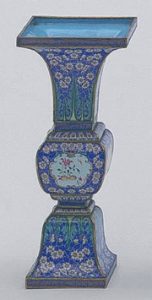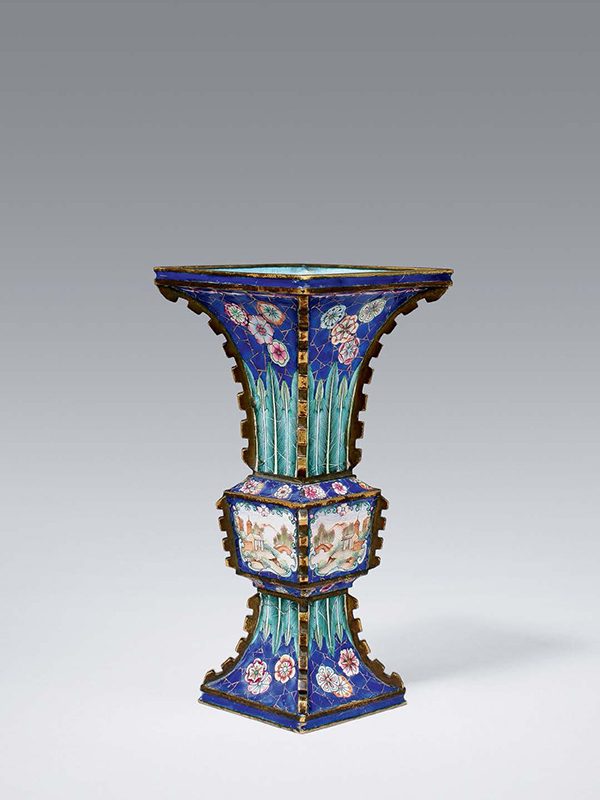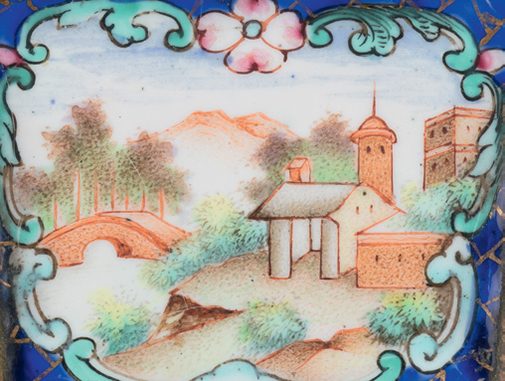Painted enamel vase, fang gu
A polychrome enamel Gu shaped vase of square section. The base is flat and forms a flared stem that leads up towards a bulbous middle section. A sloping ridge divides this area with the stem and the flaring neck of the vase, which follows. Protruding flanges ornament the edges of the vase along all three sections. The middle section of the vase is painted with four shaped cartouches, each depicting a European-style village with buildings and a bridge in a romantic landscape setting with mountains and trees. The neck and stem are decorated with a design of stylised prunus flower heads on a ‘cracked-ice’ ground and with bands of stiff leaves. The interior is painted in a pale monochrome blue and the base is painted in white. The protruding flanges, the edges of the rims and base are gilded.

Fig. 1 Painted enamel fang gu vase, Palace Museum, Beijing
This small, delicately painted fang gu vase represents an interesting combination of form and design. The fang gu shape is inspired by archaic Chinese bronze ritual vessels, which originated in the Shang dynasty (c.1500 – 1028 BC), an example of which can be found in the National Palace Museum, Taipei.[1] The inclusion of Chinese designs, such as the prunus, ‘cracked-ice’ ground and plantain leaves, coupled with European landscape scenes makes this vase extremely rare. Jesuit missionaries who arrived in China from France are thought to have been involved in the production of painted enamels in the early part of 18th century, which helps to explain the blend of decoration. In the Chinese vocabulary of decorative devices, the occurrence of flowers on a ‘cracked-ice’ ground signifies the beginning of Spring, and therefore the beginning of new life. The Qianlong period witnessed an increase in the production of painted enamels for both internal and external markets. A pair of Qing dynasty painted enamel fang gu vases, similarly decorated with ocean blue enameling on the base, green leaf decoration and prunus flower on a ‘cracked-ice’ ground, is in the collection of the Palace Museum, Beijing (fig. 1).[2] This pair of fang gu vases is part of a set of Wu Gong (five vessels for ceremonial offering), together with a painted enamel ding and two candle stick holders. A larger painted enamel fang gu vase, comparable in the European figures decoration on each side of the middle sections, is dated to the Qianlong period and in the collection of the Palace Museum, Beijing.[3]
- The National Palace Museum, Taipei online collection archive, no. 中銅1527
- The Palace Museum, Beijing online collection archive, http://www.dpm.org.cn/collection/enamel/233072.html
- Ibid. http://www.dpm.org.cn/collection/enamel/230804.html
銅胎畫琺瑯西洋人物紋方形花觚
清 乾隆 1736 – 1795 高:13.3 公分
銅胎畫琺瑯花觚,通體方形,由上、中、下三部分組成,喇叭口,鼓腹,高足外撇,沿邊四角出戟 。
通體施藍色琺瑯為地,中段部分四面開光,內飾粉色西洋山水圖,上下兩部份紋飾相對,環繪蕉葉紋
一週並以多彩皮球花裝飾。底部施以乳濁色,內裏施淺藍色,沿邊及出戟處均施以鎏金。本品器型源
自商代青銅方觚造型,成對花觚常與一香爐及二燭台組成五供,或擺放於宗祠廟宇以祭拜祖先。本件
花觚形制小但畫工細緻,並繪以少見的西洋山水圖,誠為罕見。類似品可見於北京清宮舊藏:一套清
乾隆時期藍地畫琺瑯五供中,即包含一對方形花觚,其上下段的蕉葉紋與皮球紋皆與本品極為相似 ; 另
有一件乾隆年製銅胎畫琺瑯西洋人物紋方形花觚,以黃色琺琅為地並飾以彩色西洋人物花卉紋,是此
類畫琺瑯文物中的精品。


